International Steel Prices

US HRC Holds Premium Over Imports Despite Price Declines
Written by David Schollaert
May 18, 2023
Hot-rolled coil (HRC) imports are lingering at a notable price discount to domestic hot band tags despite repeated price decreases in the US market, according to SMU’s latest foreign vs. domestic price analysis. Domestic tags are still markedly more expensive than imported product, as both offshore and US steel prices continue to ease.
![]() The price advantage domestic HRC had enjoyed over imported material turned negative in a hurry halfway through Q1 as US prices climbed at a rapid pace. And while domestic hot band prices have begun to ease quickly, declines in overseas markets have help keep the spread rather wide.
The price advantage domestic HRC had enjoyed over imported material turned negative in a hurry halfway through Q1 as US prices climbed at a rapid pace. And while domestic hot band prices have begun to ease quickly, declines in overseas markets have help keep the spread rather wide.
US HRC was less expensive than foreign hot rolled for 16 consecutive weeks starting mid-Q4 2022. But that trend ended in mid-February as domestic HRC prices surged following repeated mill price hikes. The gains outpaced the rise seen in tags abroad. Now that the trend has reversed, prices have been declining just as aggressively stateside as they are abroad, keeping the price margin between domestic and offshore product largely unchanged.
Domestic hot band is now roughly 20% more expensive than foreign material. That premium is marginally lower than last week when domestic HRC was 20.5% more costly than imported product.
US prices had been cheaper than foreign prices for the three regions we follow (Asia, Italy, and Germany) since the beginning of November after adding freight costs, trader margins, and applicable tariffs. That changed with US HRC prices jumped by more $400 per ton from early February through mid-April. But US prices inflected and are now down for five consecutive weeks.
Domestic HRC cost on average $18 per ton less than imported hot band as recently as Feb. 15. That flipped mid-Q1, with US prices ballooning to $262 per ton more expensive than offshore product as recently as April 12. The premium is now down $43 per ton, as domestic prices are on average $219 per ton more expensive than imported hot band.
SMU uses the following calculation to identify the theoretical spread between foreign HRC prices (delivered to US ports) and domestic HRC prices (FOB domestic mills): Our analysis compares the SMU US HRC weekly index to the CRU HRC weekly indices for Germany, Italy, and east and southeast Asian ports. This is only a theoretical calculation because costs to import can vary greatly, influencing the true market spread.
In consideration of freight costs, handling, and trader margin, we add $90 per ton to all foreign prices to provide an approximate CIF US ports price to compare to the SMU domestic HRC price. Buyers should use our $90-per-ton figure as a benchmark and adjust up or down based on their own shipping and handling costs. If you import steel and want to share your thoughts on these costs, we welcome your insight at david@steelmarketupdate.com.
Asian Hot-Rolled Coil (East and Southeast Asian Ports)
As of Thursday, May 18, the CRU Asian HRC price was unchanged from a week ago at $535 per net ton, but down $41 per ton from levels one month prior. Adding a 25% tariff and $90 per ton in estimated import costs, the delivered price of Asian HRC to the US is $759 per ton. The latest SMU hot-rolled average is $1,040 per ton, down $30 per ton from our previous price update last week, and also down $105 per ton compared to our price one month ago.
US-produced HRC is now theoretically $281 per ton more expensive than steel imported from Asia, down $30 per ton week-on week (WoW). This is still a reversal from mid-February when domestic HRC had a $13-per-ton advantage over HRC from Asian markets-
Just about three months ago, Asian HRC was $76 per ton more costly than US HRC. That was among some of the widest price gaps Asian HRC has had over domestic product in recent years.
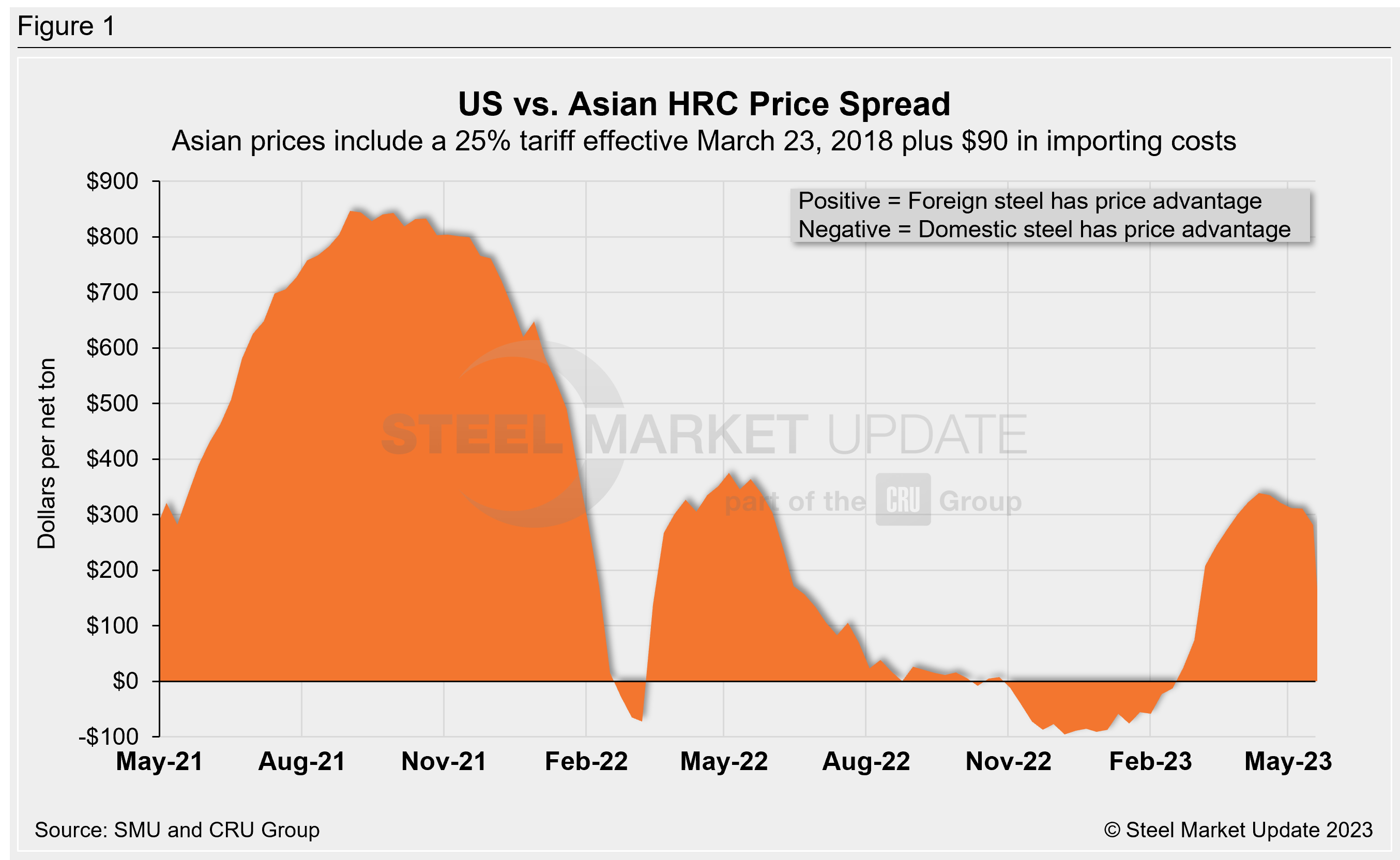
Italian Hot-Rolled Coil
Italian HRC prices decreased WoW by $44 per net ton to $757 per ton this week, and are down $94 per ton month-on-month (MoM). After adding import costs, the delivered price of Italian HRC is approximately $847 per ton.
Domestic HRC is now theoretically $193 per ton more expensive than imported Italian HRC. That spread is up $14 per ton WoW and still represents a nearly $205-per-ton reversal compared to just three months ago when US HRC was $12 per ton cheaper than Italian product. As recently as Jan. 25, US HRC was in theory $52 per ton cheaper than imported Italian hot band.
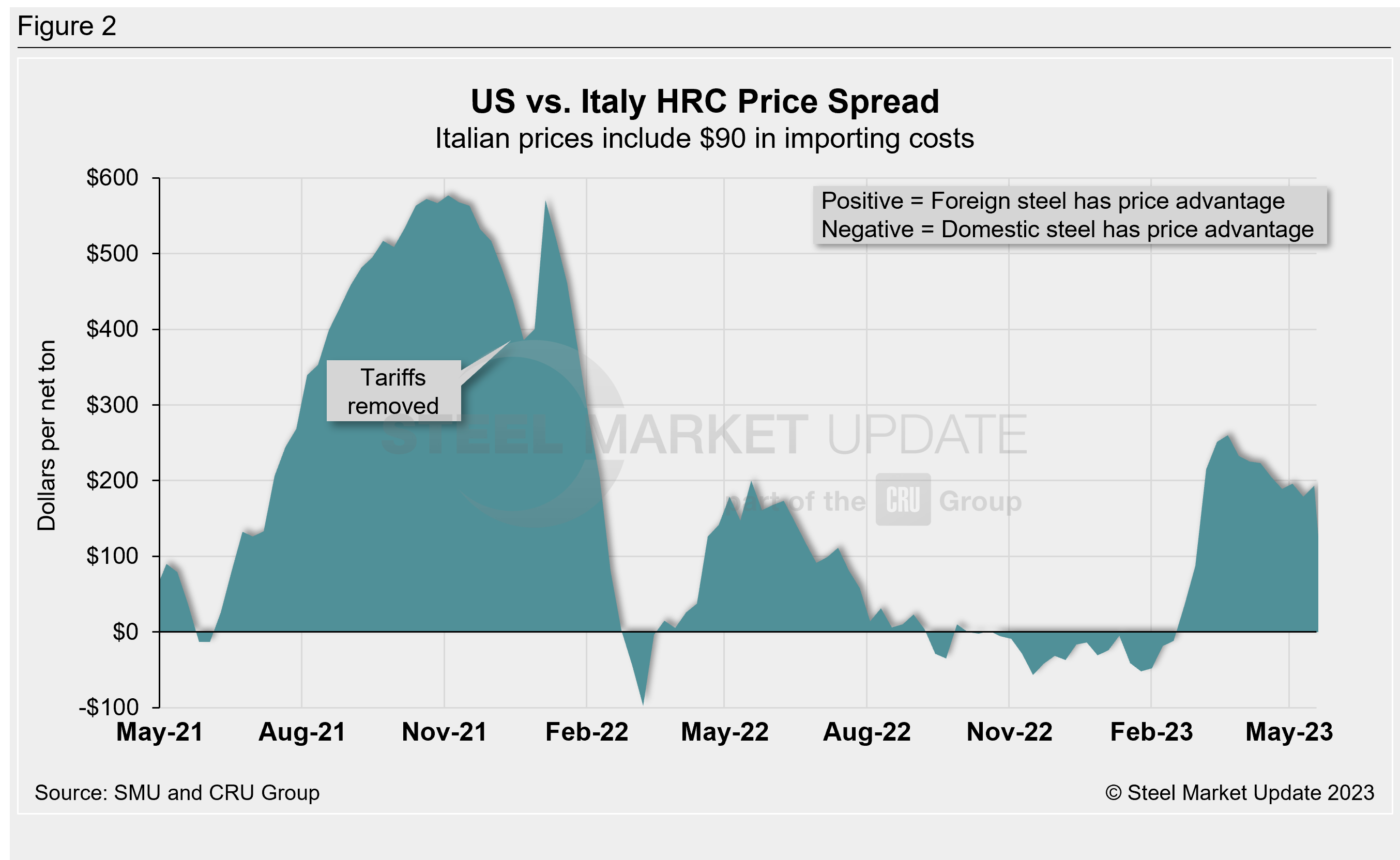
German Hot-Rolled Coil
CRU’s latest German HRC price slipped by $10 per ton WoW to $802 per net ton, down $50 per ton MoM. After adding import costs, the delivered price of German HRC is roughly $892 per ton.
Domestic HRC is now theoretically $148 per ton more expensive than imported German HRC. That’s down $20 per ton WoW but still a swing of $177 per ton given that German hot band was $29 per ton more costly than domestic HRC in mid-February.
US HRC has held a price advantage over German product for all but three weeks since late July.
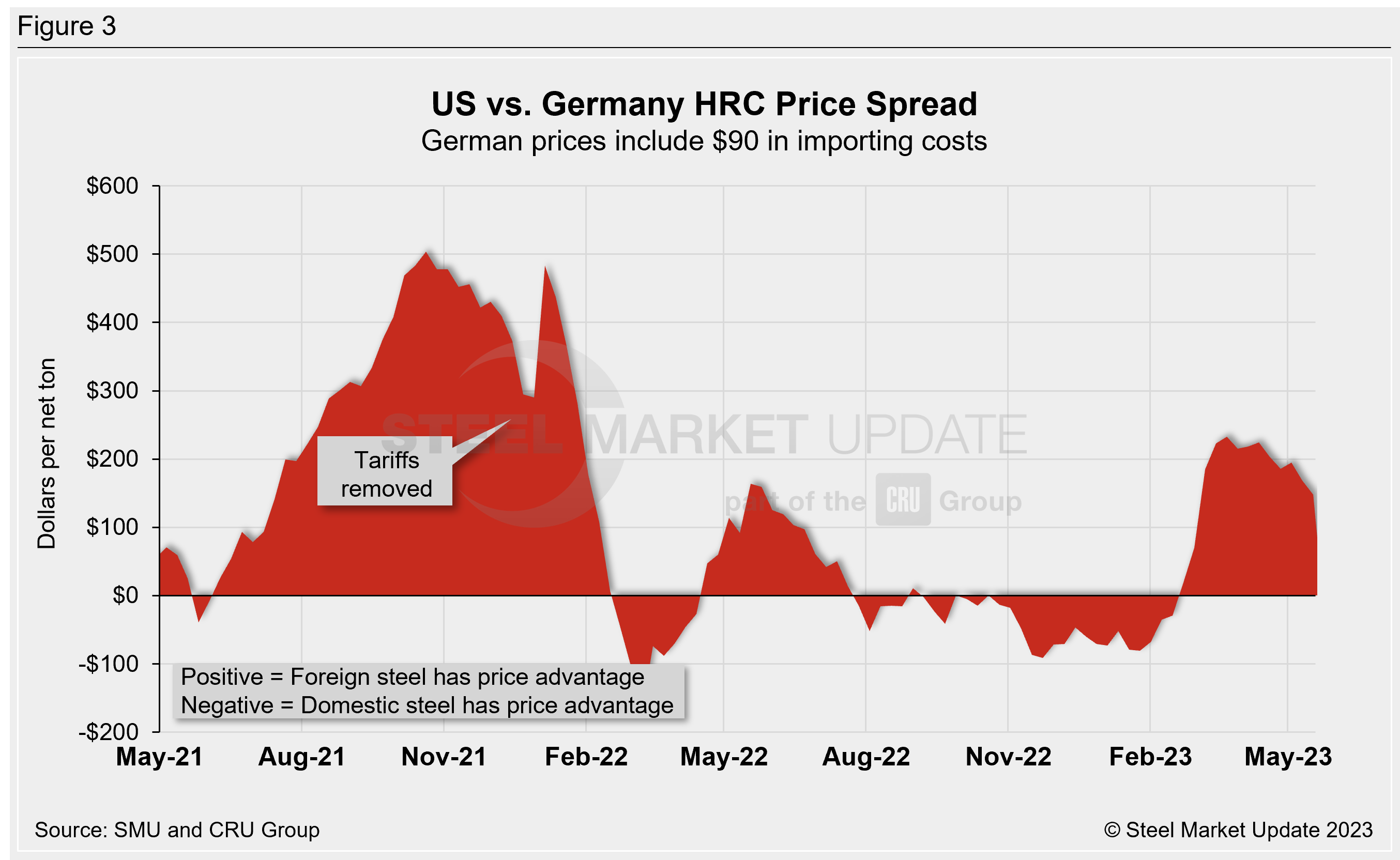
Figure 4 compares all four price indices and highlights the effective date of the tariffs. The chart on the left shows historical variation from Jan. 1, 2021, through present. The chart on the right zooms in to highlight the recent decoupling of US and offshore HRC prices.
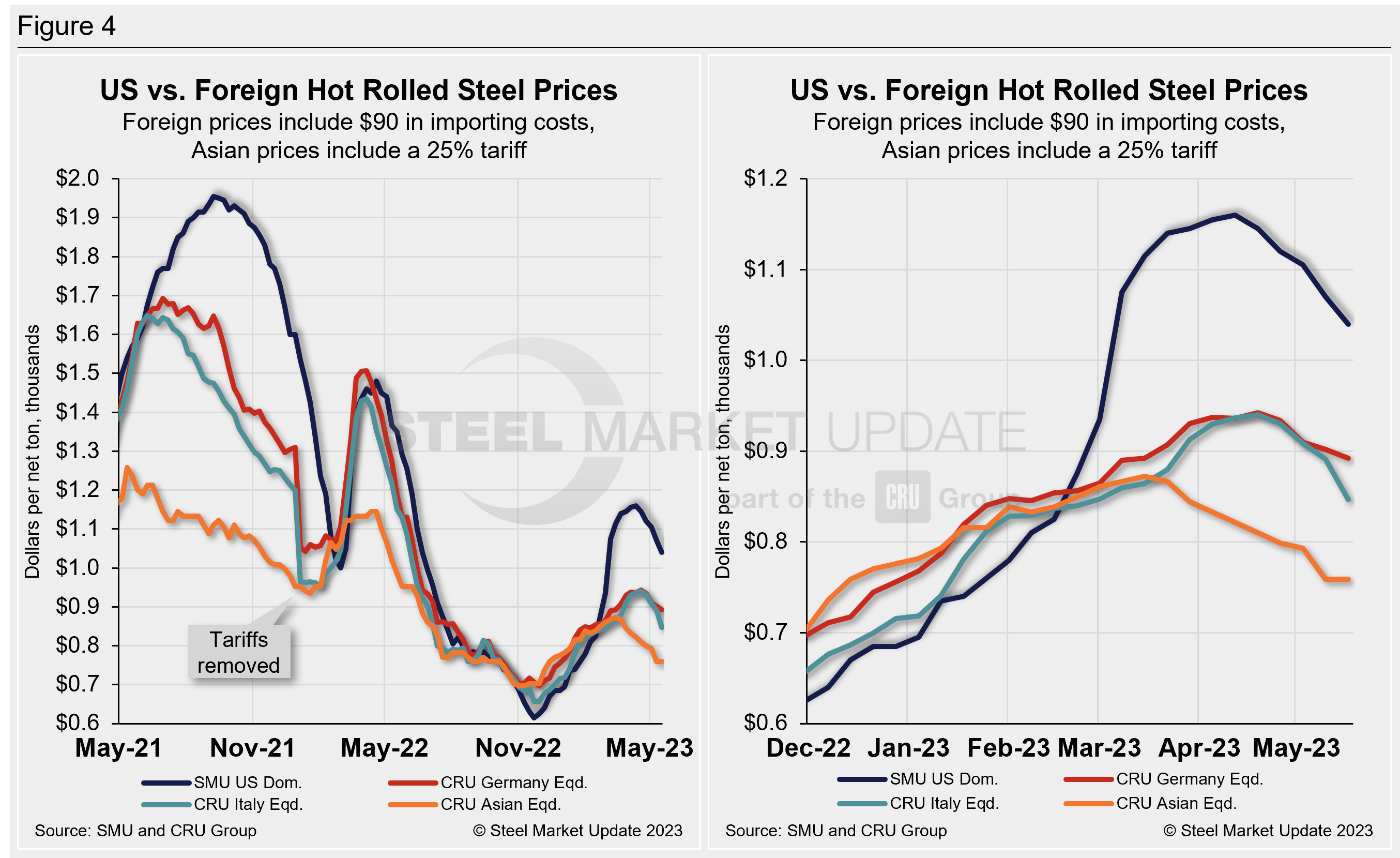
Notes: Freight is an important consideration in deciding whether to import foreign steel or buy from a domestic mill. Domestic prices are referenced as FOB the producing mill, while foreign prices are CIF the port (Houston, NOLA, Savannah, Los Angeles, Camden, etc.). Inland freight, from either a domestic mill or from the port, can dramatically impact the competitiveness of both domestic and foreign steel. It’s also important to factor in lead times. In most markets, domestic steel will deliver more quickly than foreign steel.
Effective Jan. 1, 2022, the traditional Section 232 tariff no longer applies to most imports from the European Union. it has been replaced by a tariff rate quota (TRQ). Therefore, the German and Italian price comparisons in this analysis no longer include a 25% tariff. SMU still includes the 25% Section 232 tariff on foreign prices from other countries. We do not include any antidumping (AD) or countervailing duties (CVD) in this analysis.
By David Schollaert, david@steelmarketupdate.com

David Schollaert
Read more from David SchollaertLatest in International Steel Prices
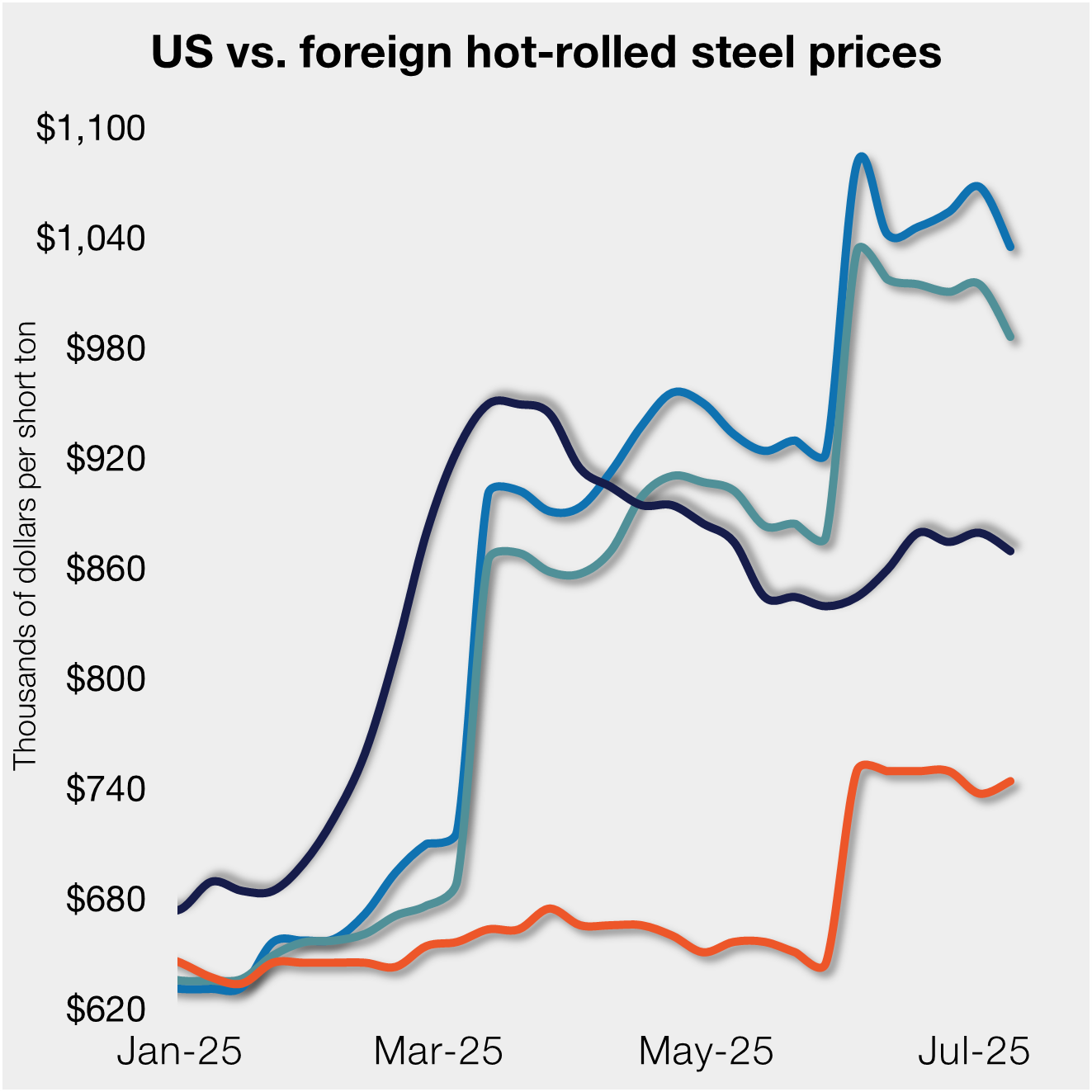
S232 tariffs keep US HR prices below imports from EU
Hot-rolled (HR) coil prices in the US ticked down this week but have fluctuated little over the past month. Stateside tags continue to trail imports from Europe, supported by Section 232 steel tariffs that were doubled in early June.

Doubled S232 tariff holds US HR prices below EU
David Schollaert presents this week's analysis of hot-rolled coil prices, foreign vs. domestic.

Higher US CR prices inch closer to EU, Japanese tags
US cold-rolled (CR) coil prices continued to tick higher this week, while offshore markets were mixed.

Stacked S232 keeps US HR prices below EU
US hot-rolled coil prices crept up again this week but still trail imports from Europe.

Doubled S232 lifts EU, Japanese CR prices over US tags
US cold-rolled (CR) coil prices edged up again this week, and most offshore markets moved in the opposite direction. But the diverging price moves stateside vs. abroad did little to impact pricing trends. The bigger impact was from Section 232, which were doubled to 50% as of June 3. The higher tariffs have resulted in […]
